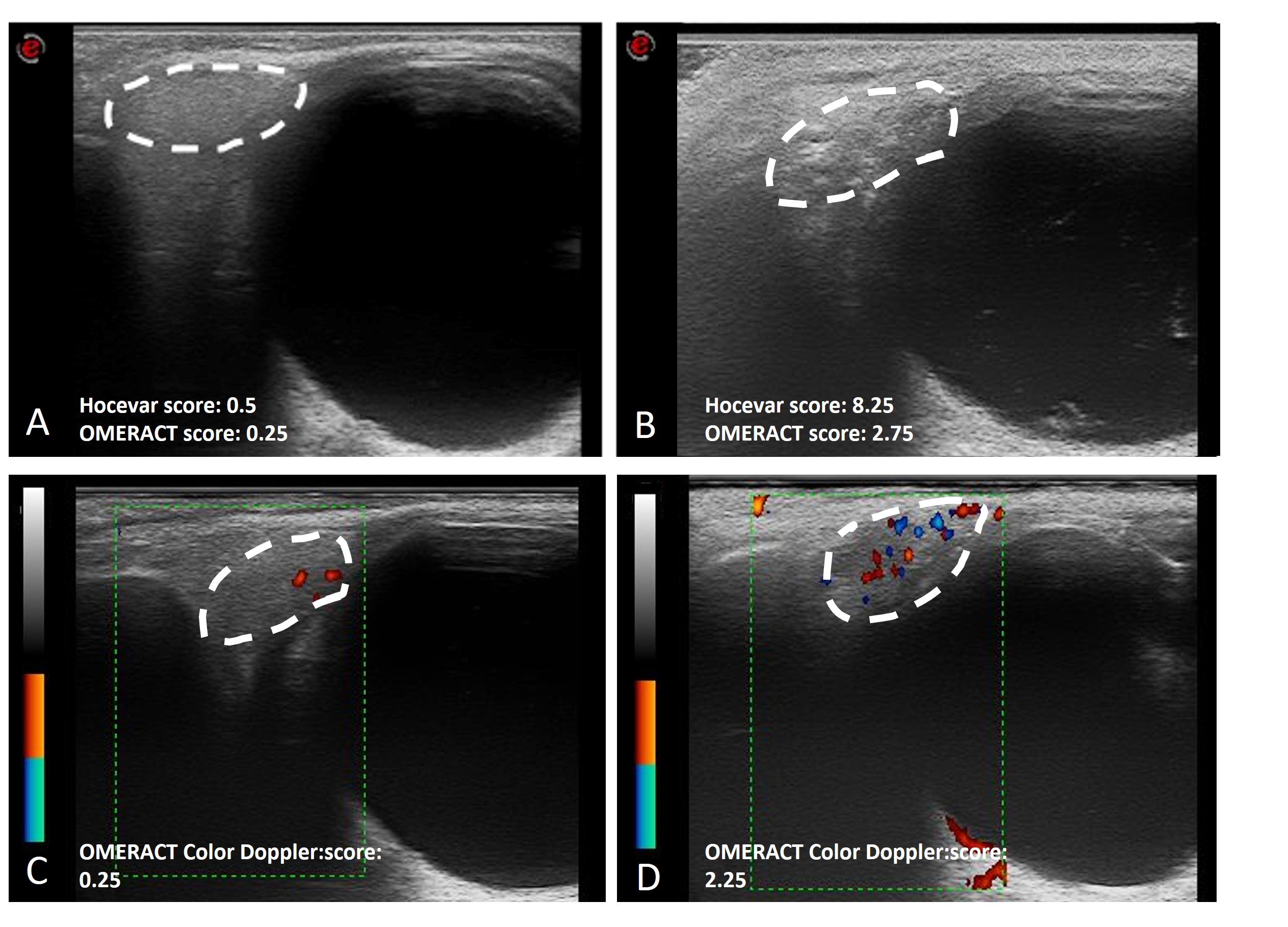Session Information
Session Type: Poster Session B
Session Time: 10:30AM-12:30PM
Background/Purpose: As a widely available, non-invasive and repeatable technique, ultrasound has already been used for the examination of irregularities of the major salivary glands. However, the studies on lacrimal gland (LG) ultrasound of SjD patients are still limited. To investigate whether ultrasound of the LG is a reliable detection modality, we conducted this study based on Hocevar and OMERACT scoring systems. Our objectives were to assess the interobserver and intraobserver reliability of ultrasound and color Doppler of LGs in patients clinically suspected of SjD.
Methods: 40 consecutive outpatients with suspected SjD underwent ultrasound and color Doppler imaging of the LGs. Four blinded observers scored the images independently in two separate sessions. OMERACT scoring of both greyscale and color Doppler was performed (both total scores range from 0-6) with images and videos. Items from the scoring system of Hocevar et al, were also assessed in both LGs, including echogenicity (compared to the surrounding tissue), parenchymal homogeneity, presence of hypoechogenic areas, hyperechogenic reflections, clearness of posterior glandular border and visibility (total score range 0-26). The interobserver and intraobserver reliability were calculated using intraclass correlation coefficient (ICC) and the ICC values were interpreted as follows: 0.00-0.20: poor;0.20-0.40: fair;0.40-0.60: moderate; 0.60-0.80: good; and 0.80-1.00: excellent.
Results: An example of LG images scored is given in Figure 1. The interobserver reliability of the OMERACT score of the LG were poor to fair, with ICCs of 0.234 and 0.158 in session one and session two, respectively, and the intraobserver reliability fair to moderate, (ICCs 0.270 to 0.536 for 4 observers in the 2 sessions). When the OMERACT scoring system was employed for color Doppler images however, a good interobserver reliability score in both scoring sessions was observed (ICCs 0.633 and 0.690), complemented by a good intraobserver reliability (ICCs 0.614 and 0.799 4 observers in the 2 sessions). In B-mode ultrasound image evaluation, using the Hocevar scoring system, interobserver reliability was fair (ICCs are 0.247 and 0.305), and that of intraobserver reliability fair to moderate (ICCs 0.340 and 0.490). Concerning the individual variables in Hocevar scoring system, the interobserver reliability of all the variables were poor to fair with ICCs less than or equal to 0.400.
Conclusion: Our single center study shows that Color Doppler ultrasound based on the OMERACT scoring system is more reliable than B-mode ultrasound for evaluation of the lacrimal gland in patients with clinically suspected SjD. Conversely, classical B-mode ultrasound used for the major salivary glands of SjD patients is unreliable for the assessment of LGs, regardless of whether the Hocevar or OMERACT scoring system is employed.
A: Ultrasound image of the left LG with an average Hocevar score of 0.5 and average greyscale OMERACT score of 0.25.
B: Ultrasound image of the left LG with an average Hocevar score of 8.25 and average greyscale OMERACT score of 2.75.
C: Color Doppler image of the left LG with an average color Doppler OMERACT score of 0.25.
D: Color Doppler image of the left LG with an average color Doppler OMERACT score of 2.25.
To cite this abstract in AMA style:
Yang T, Sluijpers N, van Nimwegen J, Stel A, Coumou A, Kroese F, Bootsma H, Delli K, Pringle S. Color Doppler Ultrasound Is a Reliable Method for Imaging the Lacrimal Glands in Patients with Suspected Sjögren’s Disease [abstract]. Arthritis Rheumatol. 2024; 76 (suppl 9). https://acrabstracts.org/abstract/color-doppler-ultrasound-is-a-reliable-method-for-imaging-the-lacrimal-glands-in-patients-with-suspected-sjogrens-disease/. Accessed .« Back to ACR Convergence 2024
ACR Meeting Abstracts - https://acrabstracts.org/abstract/color-doppler-ultrasound-is-a-reliable-method-for-imaging-the-lacrimal-glands-in-patients-with-suspected-sjogrens-disease/

